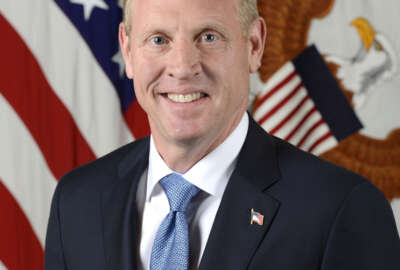 Exclusive
Exclusive DoD acquisition office saw workforce reduction, job changes despite assurances
Assistant Secretary of Defense for Acquisition Kevin Fahey said the changes, including a large workforce reduction, have been in service of innovation and speed...
The Defense Department’s Office of Acquisition and Sustainment differs more from its predecessor than anyone expected when DoD set out to split its acquisition office and reorganize the pieces back in February. Assistant Secretary of Defense for Acquisition Kevin Fahey said the changes, including a large workforce reduction, have been in service of innovation and speedier acquisition.
For one thing, back in February, Undersecretary of Defense for Acquisition, Technology and Logistics Ellen Lord said that there were no plans for a workforce reduction. But Fahey said at the Professional Services Council’s Oct. 29 Vision 2018 event, as part of the reorganization, he cut his workforce by 40 percent.
Lord also said in February that the workforce would not see changes in title, series or grade. Again, what Fahey had to say after the fact differed significantly.
“Reorganizations are really hard, because everybody’s belief is ‘change is good, just leave me the hell alone,’ right? So, as you can imagine, all the people that were in [Acquisition, Technology and Logistics] were all for the reorganization, as long as you left them alone, and we couldn’t leave them alone,” Fahey said. “One thing I did, which is the right thing to do, but makes it harder, is in my organization, I changed every single job. I did that purposely. I didn’t want anyone to think that they were doing the same job they were doing before we reorganized. So everybody in my organization got a letter telling them what their new job was and who their new supervisor was, which I think was the right thing to do.”
Fahey also discussed ways the organization attempted to streamline its decision-making processes.
Former Undersecretary of Defense for Acquisition, Technology and Logistics Frank Kendall had 30 people reporting directly to him on various projects, Fahey said, but Lord has cut that number significantly. Lord said in May that under the reform effort, DoD delegated milestone decision authority for most major defense acquisition programs back to the services. She still oversees joint programs such as the F-35, the nuclear triad, and the operational control system (OCX) satellite program.
Fahey said that cut a lot of the direct oversight out of the job, though he and Lord attempt to stay informed on the programs in order to help whenever possible.
“I’m a big believer that if you delegate authority and responsibility to the lowest level, you’re going to get real innovation,” he said. “You’re also going to get people to take responsibility for what they’re doing. You will get speed, if you think about it. They can make decisions at lower levels now. When I had to go through a milestone decision process, no exaggeration, you were lucky if it was six months.”
He said that back then, there were always calls for more data, because no one ever felt comfortable taking final responsibility for that much money.
And Fahey said Lord doesn’t want to pull those authorities back either. Though Congress has concerns about transparency and whether Lord and Fahey can maintain their knowledge about the programs, Fahey said Lord would much rather help someone in trouble than retract the authorities.
And whether those programs eventually succeed or fail, everything goes to the Defense Acquisition University, Fahey said, because you can learn as much from what doesn’t work as what does.
That’s also part of an effort to reduce the DAU’s compliance-based curriculum and begin to include less conventional methods, like Other Transaction Authorities.
“We’ve still got to do it, it’s required by law, you’ve still got to do certifications,” Fahey said. “But we want as much of what [Lord] calls real-time graduate school training.”
For example, Fahey said DoD needs to clear up some misconceptions about OTAs, and teach people why they’re actually used.
“The one thing we’ve got to make clear is sometimes there’s the idea that if we do an OTA, or middle tier, I get out of acquisition free,” he said. “That’s not the intent on anything.”
People still need to do all their homework, Fahey said. They still have to test things, make sure they’re suitable, effective and survivable. But DoD needs to figure out how to do it faster, which is something it’s been working with Congress on, to implement the necessary authorities.
Copyright © 2024 Federal News Network. All rights reserved. This website is not intended for users located within the European Economic Area.
Daisy Thornton is Federal News Network’s digital managing editor. In addition to her editing responsibilities, she covers federal management, workforce and technology issues. She is also the commentary editor; email her your letters to the editor and pitches for contributed bylines.
Follow @dthorntonWFED
Related Stories






